Last edited by a moderator:
-
Welcome to rpgcodex.net, a site dedicated to discussing computer based role-playing games in a free and open fashion. We're less strict than other forums, but please refer to the rules.
"This message is awaiting moderator approval": All new users must pass through our moderation queue before they will be able to post normally. Until your account has "passed" your posts will only be visible to yourself (and moderators) until they are approved. Give us a week to get around to approving / deleting / ignoring your mundane opinion on crap before hassling us about it. Once you have passed the moderation period (think of it as a test), you will be able to post normally, just like all the other retards.
You are using an out of date browser. It may not display this or other websites correctly.
You should upgrade or use an alternative browser.
You should upgrade or use an alternative browser.
Incline Quake II enhanced re-release by Nightdive Studios
- Thread starter Feyd Rautha
- Start date
Ivan
Arcane
meh, I'll get excited when iD does a new single player Quake 1 sequel. Trent Reznor/NIN returning for music would be ace
https://nordic.ign.com/quake-ii/68689/news/quake-2-remastered-rating-spotted-ahead-of-quakecon-2023
Quake 2 Remastered Rating Spotted Ahead of QuakeCon 2023
Quake 2 Remastered appears to be in the works after a rating for the unannounced shooter was spotted online.
Gematsu spotted the Quake 2 Remastered listing on the reliably leaky Game Rating and Administration Committee of Korea. At the time of publication, the listing is still live, and confirms a release on PC. IGN has asked Bethesda for comment.
The listing describes Quake 2 Remastered as: “An FPS game that wages war against the hostile alien race, Strogg, who plans to invade the earth.” It includes “excessive expression of violence”, and “blood and body damage are frequently expressed in the process of fighting using weapons”.
The listing comes just weeks before QuakeCon 2023 kicks off August 10. As Gematsu pointed out, in 2021 the Game Rating and Administration Committee of Korea rated the remastered version of the original Quake ahead of its official announcement at QuakeCon 2021.
Quake Remastered released for PC, Xbox One, PS4, and Nintendo Switch, so it seems likely Quake 2 Remastered is set for PC and the full set of consoles, too. And given Bethesda is owned by Microsoft, Quake 2 Remastered will no doubt launch straight into Xbox Game Pass, as Quake Remastered did.
Quake 2 first launched in 1997. The Id Software first-person shooter continued the Quake storyline set out by its predecessor, and would go on to spawn two sequels and a number of spin-offs.
potatojohn
Arcane
- Joined
- Jan 2, 2012
- Messages
- 2,646
Can't wait for more garbage, unplayable remakes full of bugs.
Zboj Lamignat
Arcane
- Joined
- Feb 15, 2012
- Messages
- 5,778
Bruh, don't even say stuff like that. You know how this would end, right?meh, I'll get excited when iD does a new single player Quake 1 sequel. Trent Reznor/NIN returning for music would be ace
ferratilis
Arcane
- Joined
- Oct 23, 2019
- Messages
- 2,906
They're announcing a Quake reboot in August, mark my words. Hugo Martin will make you his bitch.
https://nordic.ign.com/quake-ii/68689/news/quake-2-remastered-rating-spotted-ahead-of-quakecon-2023
Quake 2 Remastered Rating Spotted Ahead of QuakeCon 2023
Quake 2 Remastered appears to be in the works after a rating for the unannounced shooter was spotted online.
Gematsu spotted the Quake 2 Remastered listing on the reliably leaky Game Rating and Administration Committee of Korea. At the time of publication, the listing is still live, and confirms a release on PC. IGN has asked Bethesda for comment.
The listing describes Quake 2 Remastered as: “An FPS game that wages war against the hostile alien race, Strogg, who plans to invade the earth.” It includes “excessive expression of violence”, and “blood and body damage are frequently expressed in the process of fighting using weapons”.
The listing comes just weeks before QuakeCon 2023 kicks off August 10. As Gematsu pointed out, in 2021 the Game Rating and Administration Committee of Korea rated the remastered version of the original Quake ahead of its official announcement at QuakeCon 2021.
Quake Remastered released for PC, Xbox One, PS4, and Nintendo Switch, so it seems likely Quake 2 Remastered is set for PC and the full set of consoles, too. And given Bethesda is owned by Microsoft, Quake 2 Remastered will no doubt launch straight into Xbox Game Pass, as Quake Remastered did.
Quake 2 first launched in 1997. The Id Software first-person shooter continued the Quake storyline set out by its predecessor, and would go on to spawn two sequels and a number of spin-offs.
Most likely Nightdive, even though there's no confirmation yet.
Can't wait for more garbage, unplayable remakes full of bugs.
Doom 64 re-release and Quake Enhanced are perfectly playable, as GOG releases anyway. The only bug with Q1E I've seen so far was a fucked up hitbox on a zombie, the grenades would just go through it. I don't know if that was new. Some random audio crackling too in areas that use the wind howling ambient track. Reloading seems to tone it down some. Could be an issue with some particular sample rates selected for audio mixers, as I've had similar problems with other games that can't handle high sample rates (Tomb Raider: Underworld).
Last edited:
- Joined
- May 27, 2010
- Messages
- 1,584

duskvile
Fabulous Optimist
- Joined
- Jun 3, 2023
- Messages
- 292
I wish it would be full from the ground remake in UE5.

Hopefully the two expansions are part of the package not unlike the ones for Q1 were.
ferratilis
Arcane
- Joined
- Oct 23, 2019
- Messages
- 2,906
randir14
Augur
- Joined
- Mar 15, 2012
- Messages
- 762
I guess Nightdive isn't involved. No mention of them in the trailer and no announcements on their social media. The new version is free if you already own the game btw. I noticed the install size in Steam was now over 5gb, so I downloaded it and it's the remaster.
Played a few levels and it's a good remaster. It runs as smoothly as Yamagi, the graphics have some nice little upgrades (although the new lighting makes it look more colorful than the original). The cutscenes are either AI enhanced or completely remade. Sound is a little higher quality and now has reverb, it also seems like they added back in some cut sound effects. Also guns now actually have muzzle flashes.
-edit I was wrong, Nightdive made it and they're now listed on the Steam page.
Played a few levels and it's a good remaster. It runs as smoothly as Yamagi, the graphics have some nice little upgrades (although the new lighting makes it look more colorful than the original). The cutscenes are either AI enhanced or completely remade. Sound is a little higher quality and now has reverb, it also seems like they added back in some cut sound effects. Also guns now actually have muzzle flashes.
-edit I was wrong, Nightdive made it and they're now listed on the Steam page.
Last edited:
soutaiseiriron
Educated
- Joined
- Aug 8, 2023
- Messages
- 293
Lighting is a lot brighter than the original. Texture filtering is forced on when I'm on Vulkan, even if I toggle it off. Equipment wheel is really nice since the original game is terrible with handling the inventory and I don't think any other source ports add this.
Other than that it's just like the Quake 1 port, perfectly fine.
Other than that it's just like the Quake 1 port, perfectly fine.
ferratilis
Arcane
- Joined
- Oct 23, 2019
- Messages
- 2,906
It's more than Quake 1 port. Restored content, improved AI and a bunch of other changes.
https://bethesda.net/en/article/6NIyBxapXOurTKtF4aPiF4/enhancing-quake-ii
https://bethesda.net/en/article/6NIyBxapXOurTKtF4aPiF4/enhancing-quake-ii
GET THE FULL TECH RUNDOWN ON THE ENHANCED QUAKE II
AUGUST 10, 2023
The new release of Quake II packs tons of enhancements under the hood. Many are modern additions while others are improvements made by reiterating techniques from its original 1997 release.
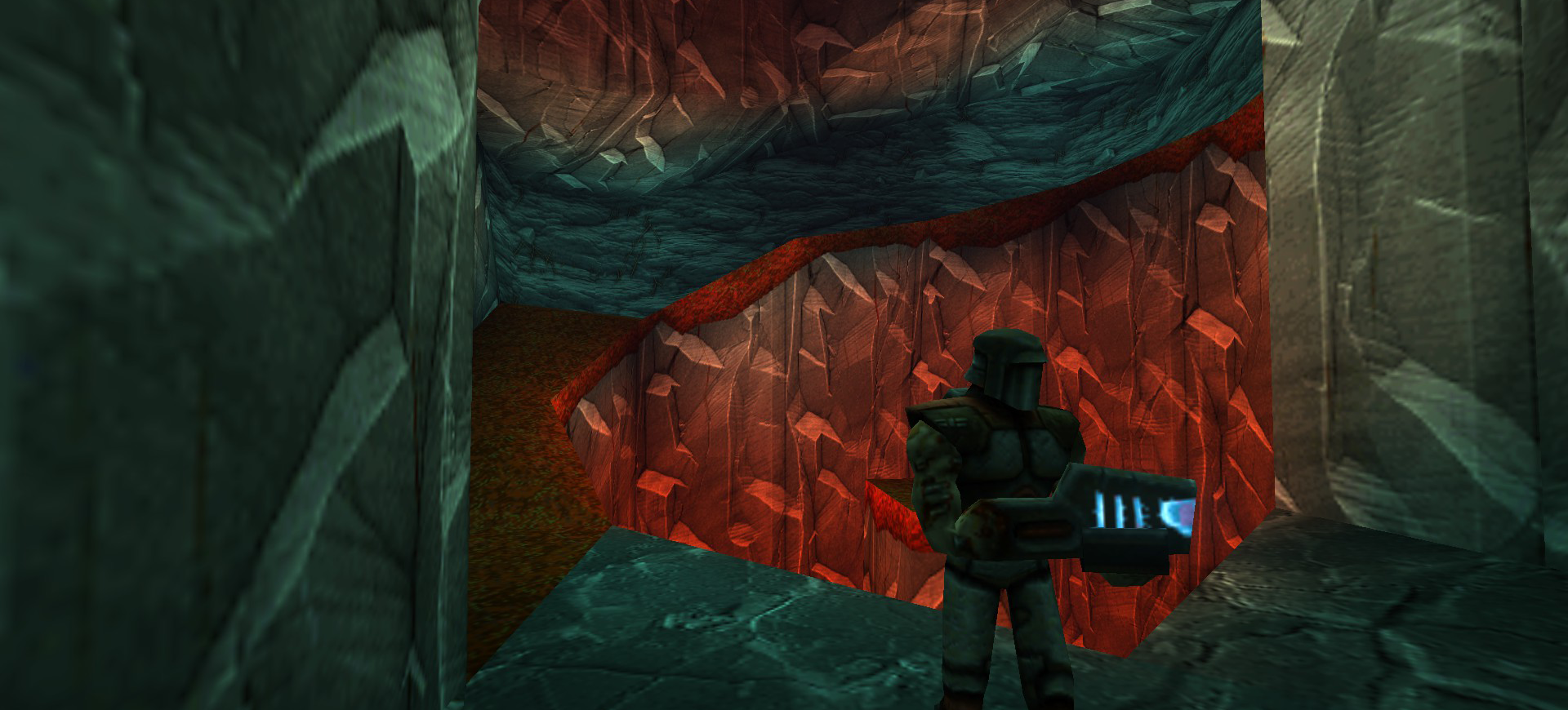
The new release of Quake II packs tons of enhancements under the hood.
Many are modern additions such as dynamic shadows, while others are improvements made by reiterating techniques used for Quake II’s original 1997 release.
With the gameplay still perfectly preserved from its 90s’ debut, here’s a rundown of the major technical enhancements, improvements and even collaborations involved to bring Quake II to a new generation of players. Whether you are a veteran modder, retro gaming enthusiast or simply curious what makes this release of Quake II tick, this is for you!
MAP COMPILING TOOLS
Similar to the original 1997 release, most of the lighting in Quake II is baked into the BSP file at compile-time. Lighting is pre-calculated by the lighting tool and a packed texture of just the lighting is saved into the BSP file.
We worked with two contributors of the popular ericw-tools, Eric Wasylishen and Jonathan Barkley, to improve support for Quake II’s BSPs. We also went beyond the original game’s support to allow for better lighting in both the original maps and user maps.
Baking lighting is still entirely a CPU-based process and can be run on headless machines without any GPU at all. When lighting the original maps on 1997 PCs a final bake would often take hours, even potentially overnight. With more per-megahertz efficiency and dozens of cores at our disposal, lighting your own map with all the modern bells and whistles can be done in a few minutes.
Increased Luxel Density
Despite the fancy jargon, this map compiler improvement is a simple one: the original game would light the world at a 16:1 ratio - every 16 units in the game would map to one light sample. We rebuilt all maps and increased this to 8:1, a 4x increase in detail. The effect is subtle in areas with lots of diffused lighting, but areas with spotlights casting hard shadows benefit greatly.

Light Grid Support
This map compiler feature that was brought back from Quake III Arena. A challenge with the original Quake II’s lighting is that entities are lit based on where they are standing on the ground. This tends to work well enough for ground-based items and enemies, but the system struggles when you have flying monsters. They will often be dark in midair because they happen to be passing over a low-angle shadow or something similar.
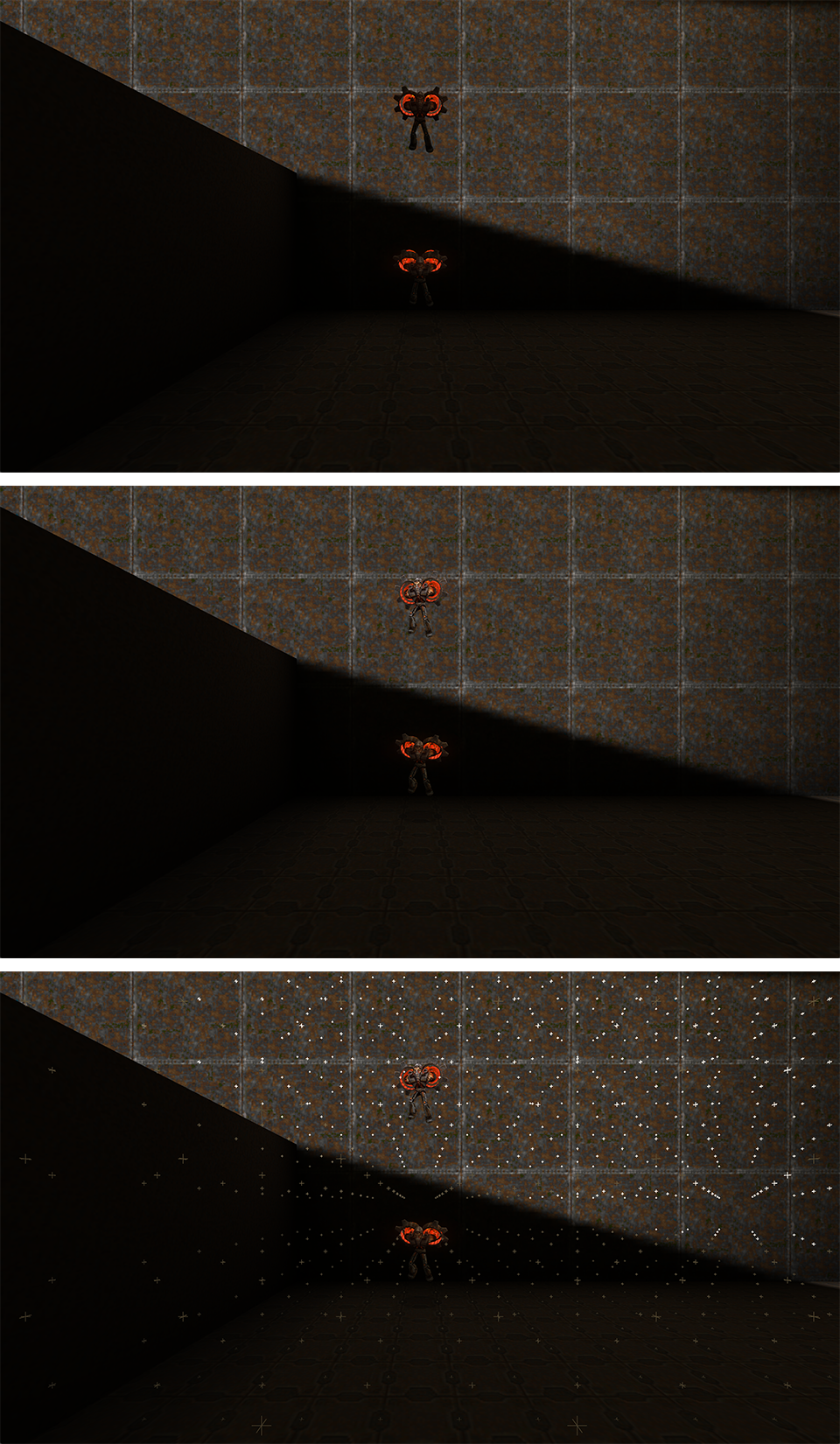
In addition to storing the lightmaps, we now store a voxel grid within the sealed world space containing a sample of light as all the contributing rays are cast through that area. It’s a fairly simple system mostly relying on increased file size and memory for maps, which is likely why it wasn’t used until Quake III Arena.
Texture Independent Lighting
Another concept backported from Quake III Arena is how lightmaps are stored in relation to surfaces. In the original Quake II, skewing or scaling textures would also cause the lightmap to similarly skew or scale. Now, lightmaps are stored based on the size of the brush rather than the size of the texture.

Baked Ambient Occlusion
One of the earliest enhancements made in ericw-tools is ambient occlusion, also known as dirt mapping, which helps add depth to the world by darkening corners to reflect that they generally receive less light bouncing around.

Phong Shading
After Quake II shipped, a tool named ArghRad was released. It was an enhanced lighting tool with support for Phong shading. This is an ancient technique dating back to the 1970s that adjusts lighting on a low polygon surface. This can help sell the effect of something being rounded without rebuilding the structure to have more polygons. Our updated maps use this technique where appropriate.

Translucent Materials
Another change that really sells the lighting of a space, translucent textures allow incoming light rays to pass through and contribute some of their texture color to the destination. This means that colored glass, holograms, terminals and other brushes can have light shining through them and appropriately affect the lights going through them.
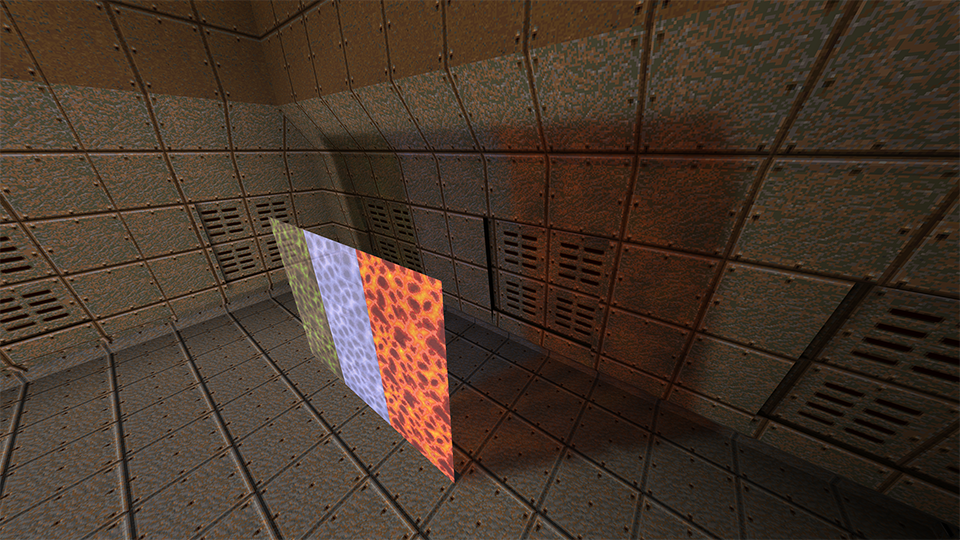
Lit Liquids
This is a feature gaining traction in the Quake mapper community because it is a huge improvement when making maps with liquids of any size. In the original, water was not lit at all and always appeared at full brightness. Now, liquid surfaces can receive lightmaps like any other surface without blocking the rays underneath.
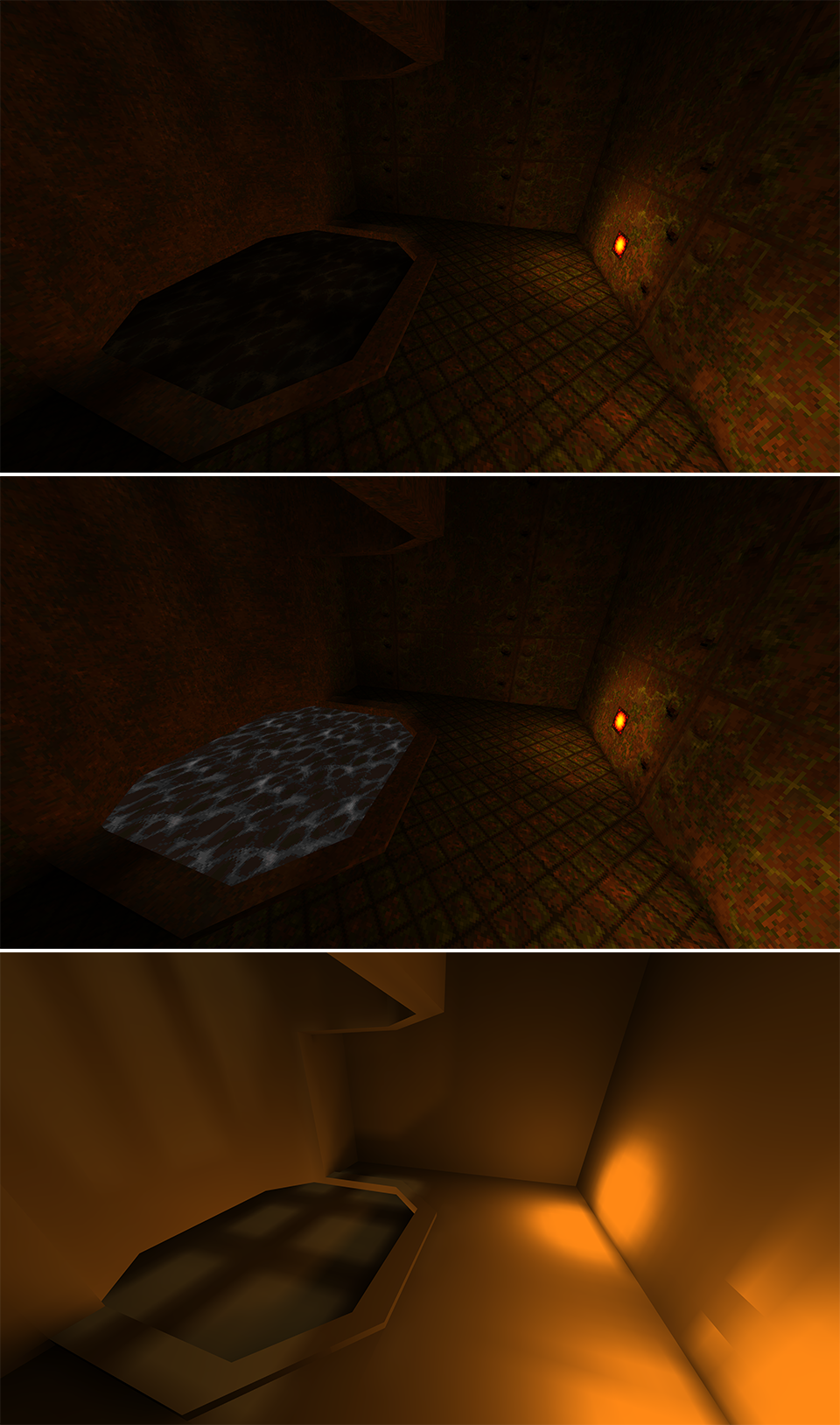
GRAPHICS
The hot new feature for Quake II back in the day was colored lighting. Nowadays such a feature is downright quaint, but our new release of Quake II has some modest upgrades to improve on what’s there while still remaining faithful to the original art.
Animation
Paul Steed’s animations in Quake II added an incredible amount of character to the world. From subtle twitches and idle animations to over-the-top flips and dives, you were never sure what enemies were going to do. For a lot of us playing the game for the first time back then, seeing a guard duck under incoming blaster fire was a “holy shit” moment. However, there were some limitations to the tech back then that stopped these animations from hitting their full potential.
First and foremost, the MD2 model format has a limited range when it comes to vertex precision. This is what leads to the “wiggle” effect you’d see, especially on the first-person gun models. We were able to recover the original animation files for most of the models in the game and used these high-resolution animations to create skeletal animations for the enhanced models, eliminating the wiggle.

Switching over to skeletal animation also fixed up some cases where linear interpolation failed. This is most noticeable in the Parasite’s death animation where he would flip and rotate so fast that the linear interpolated animation would result in the parasite becoming polygon soup.
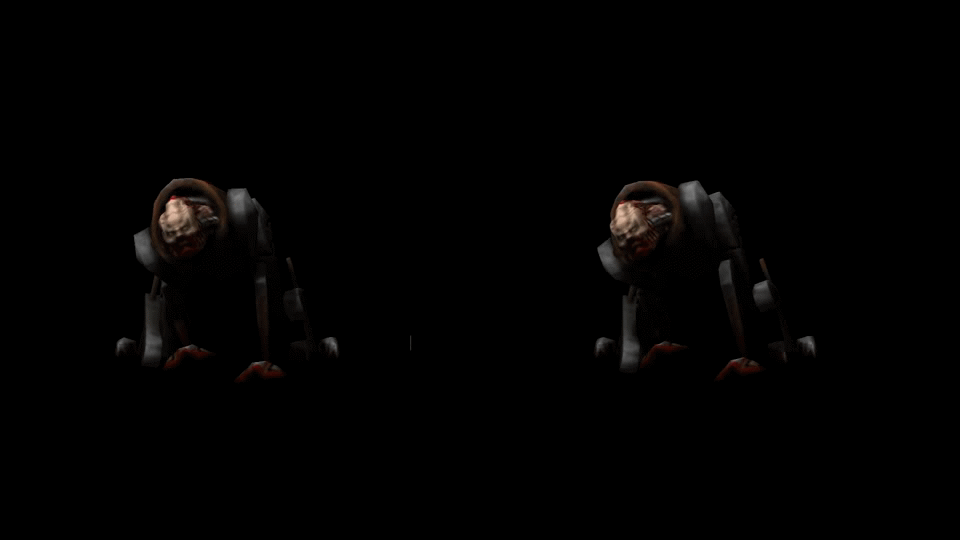
Glowmaps
Quake II has a lot of screens and lights in textures, such as glowing parts on weapons. In the base engine, however, they are affected by light and dark like anything else. We now support glowmaps, which is a mask applied over the texture that specifies which areas should glow. This means lights on enemies will glow in the dark and lights on weapons will now light up, which enhances the painted in lighting details on the existing skins.

Height Fog
We have extended our support for fog, adding support for height-based fog which lets mappers specify two different colors. This is done as a post-processing effect rather than a volume in-map. This has some tradeoffs, but it is a great effect for mappers to diversify spaces.
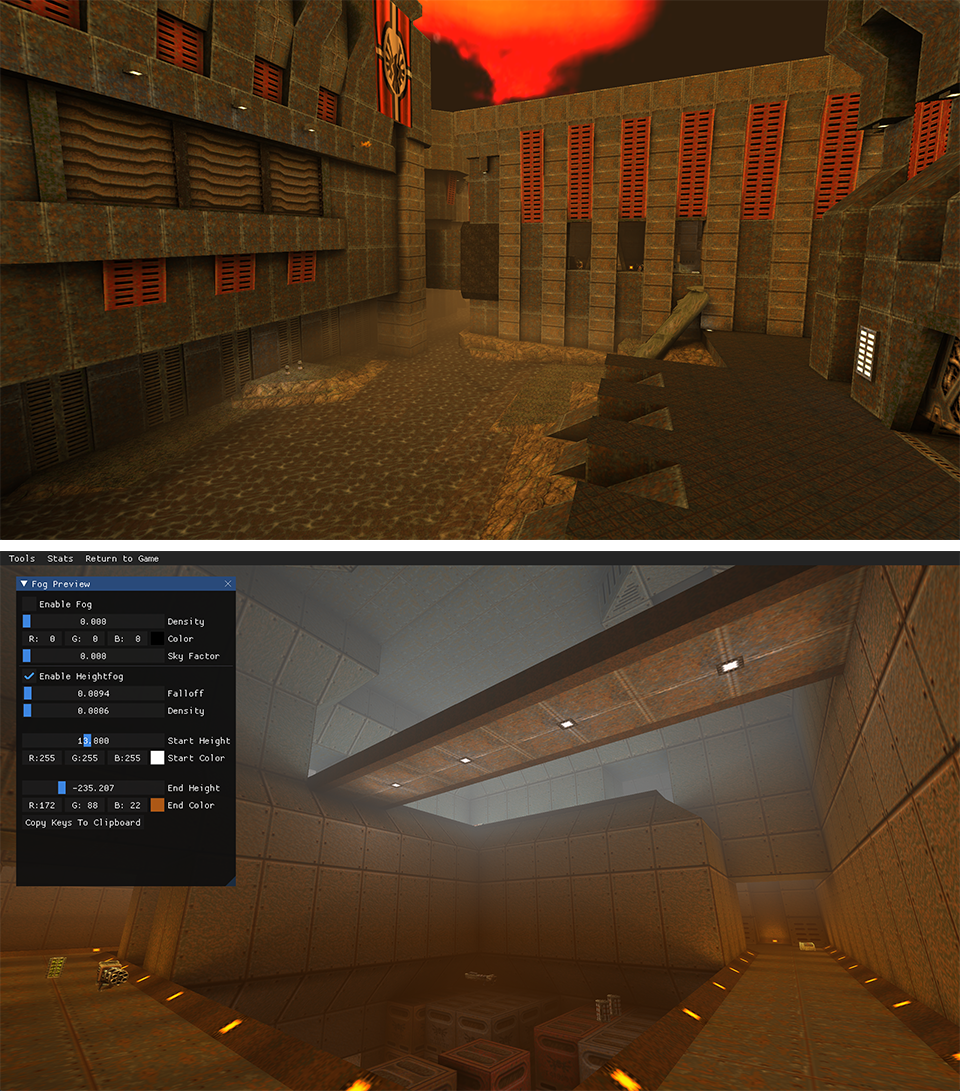
Muzzle Flashes
While not strictly a tech addition, it is a change that has such a positive impact on gameplay that we’re going to include it anyway! Weapons on both players and enemies now have muzzle flashes when fired in addition to the dynamic lights. This helps players quickly identify who is firing at you, especially in well-lit rooms where the dynamic lights might not be so visible.
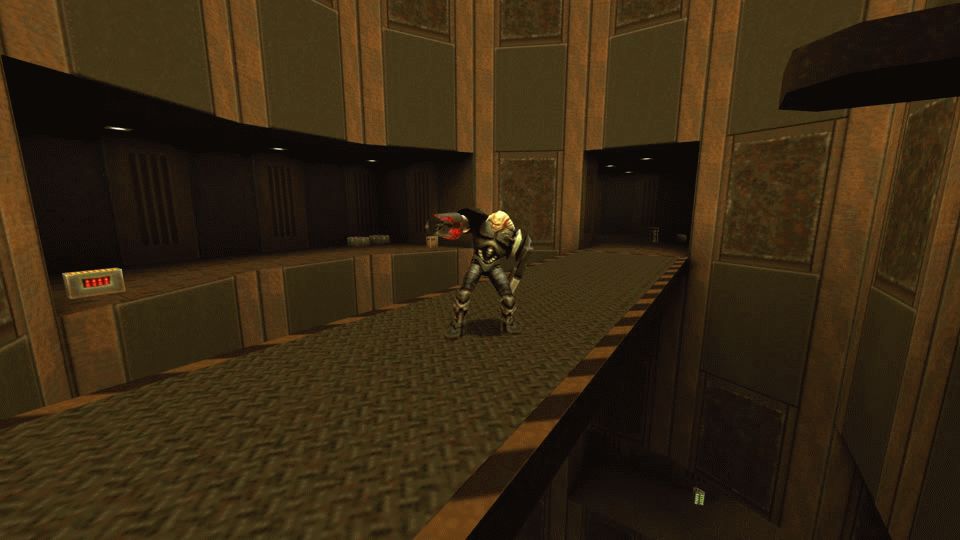
AUDIO
We’ve made improvements to the audio in our enhanced Quake II release. In addition to fixing bugs in the original audio code and raising limits to support more voices with our faster CPUs, we now support attaching a material name to each texture.
This serves two purposes: the first is to allow traces to return the material of the surface it hits, allowing for unique footsteps for each surface. The second is we now calculate a rough estimate of room size and materials in the room to select a reverb preset. This makes being underground in a sewer sound different than a grassy outdoor area.
Artificial Intelligence
The AI in Quake II went through quite a bit of changes during development. Quake II was originally meant to use QuakeC but late in development, the decision was made to switch over from interpreted code to a native library. This led to having to port all the existing QuakeC over to C and in the process, the AI was simplified to be a bit more like the original Quake. In this rerelease, we were able to build upon the bots and expose more of their internal logic to the enemy AI.
Improved Navigation
We have exposed many of the bot navigation functions to the game DLL, allowing the game to manage route planning to and from arbitrary points. The AI still requires manually placed navigation points, however; while we initially investigated navmesh generation through solutions like Recast, we decided that it would not fit within our development schedule and decided instead on improving the existing tools for bots.
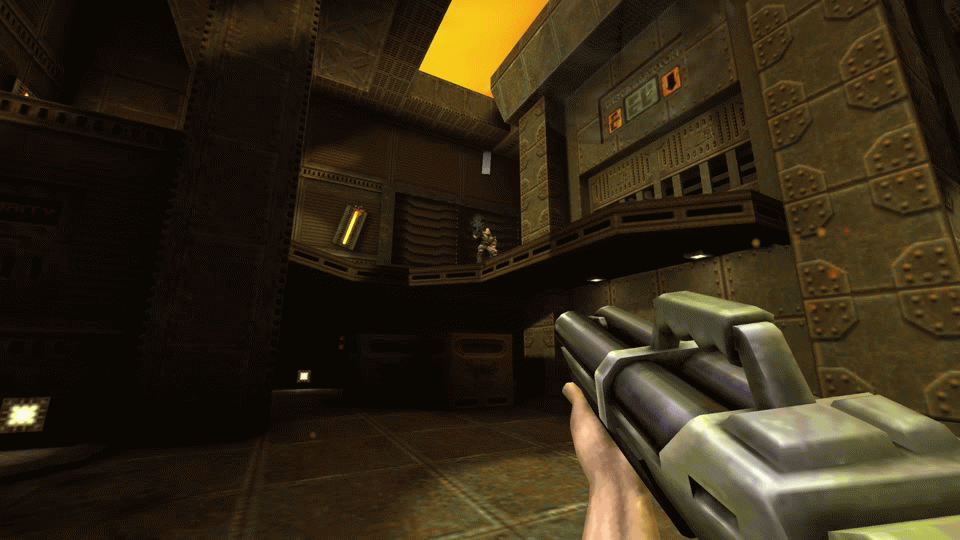
The original Quake II AI had some very basic functions to feel its way through the environment. Now, the AI can set a goal to move near you and route around complex rooms with stairs or take advantage of traversal points to jump down.
Improved Decision Making
AI decision making has been improved and enemies will act with more depth compared to the original release. Enemies have a much better time determining if they can even hit you, especially those with multiple attacks.
For example, a Gunner whose chaingun arm is blocked by a wall will instead use their grenades rather than unload their munitions into the corner. Enemies will also sometimes choose to fire while closing distance instead of waiting until they reach their movement goal. These changes help prevent the AI from making poor choices without really changing how they behave or fight.
New Flying AI
Flying AI has been completely revamped to look more natural and will decelerate and glide into turns instead of making sudden stops. Swarms of Flyer drones will bump into and deflect off each other as they jockey into position.
Restored Content
Anyone who has dug around the original Quake II files has found extra animations that were never used in its initial release. We went through these, polished them up and re-added them to the game. For example, the Technician now extends its fearsome claws to announce an ambush and the Berzerker has become even fiercer with a leaping ground attack.
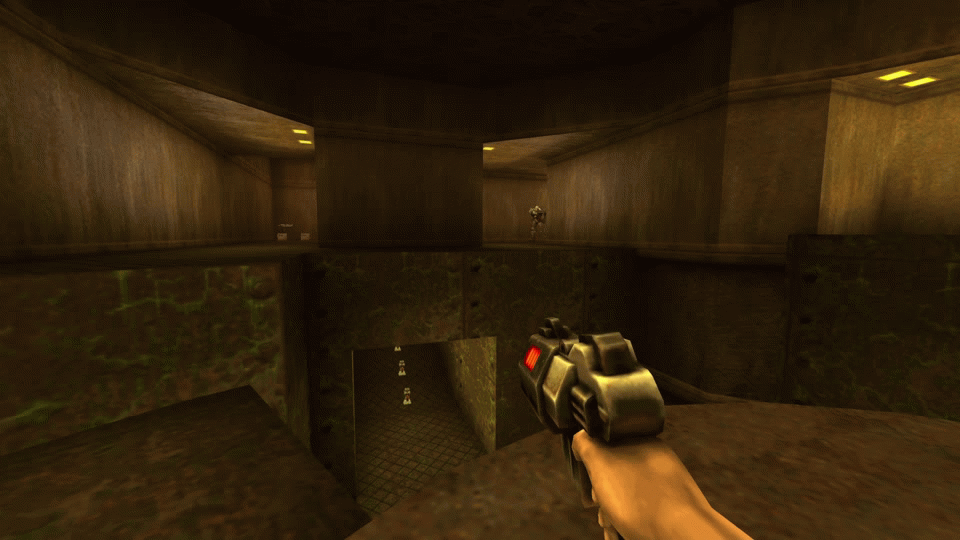
The Parasite has had a couple of changes to make it more fun to fight. Its proboscis is now a projectile that can be dodged and will lodge itself into a wall. We’ve added this mechanic so that the Parasite can use its tug and flip animation, as it remains vulnerable after a missed attack.
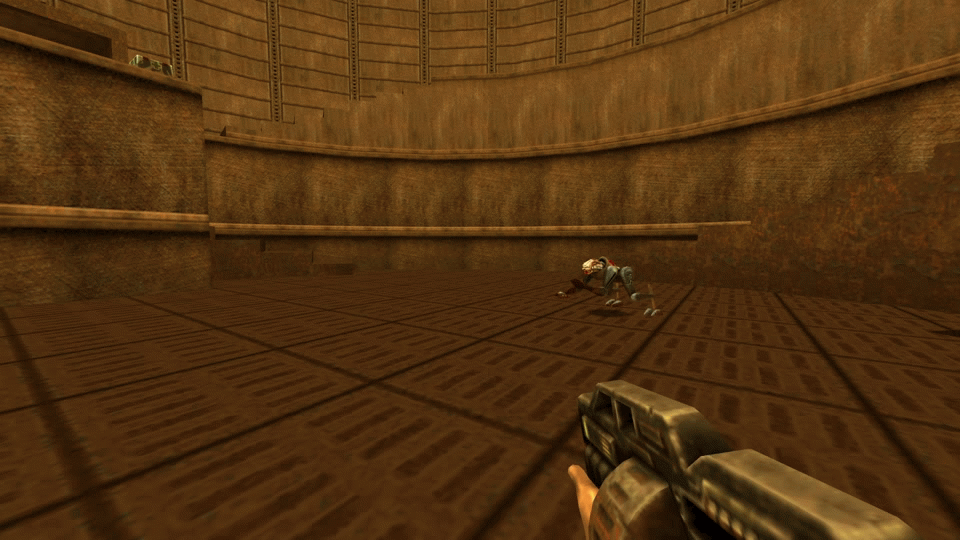
BOTS
Here are some new bot features for the enhanced release of Quake II:
Data Driven Bots for Mod Support
- Bots can now access hard-to-reach areas such as the Megahealth on The Edge using rocket jumping
- All weapons, items and powerups in the game are understood and used when appropriate.
- All enemies are understood and will be attacked if hostile
- Bots can jump, crouch, ride elevators/platforms, use ladders, trigger traps for enemies and avoid traps themselves
- High level commands from the game DLL allow modders to control where bots go and what they do
- Add new items, weapons and enemies to your mod and just add an entry to a simple text file to allow the bots to see and understand them (more on that below)
Bots are designed to support mods quickly and as easily as possible through a collection of data files explaining which entities are of interest to them and how those entities work. For any mod creator, it’s as simple as creating their own mod-specific definition files for their unique weapons, items, monsters, etc.
The list of files available and an example from the items file can be seen below:
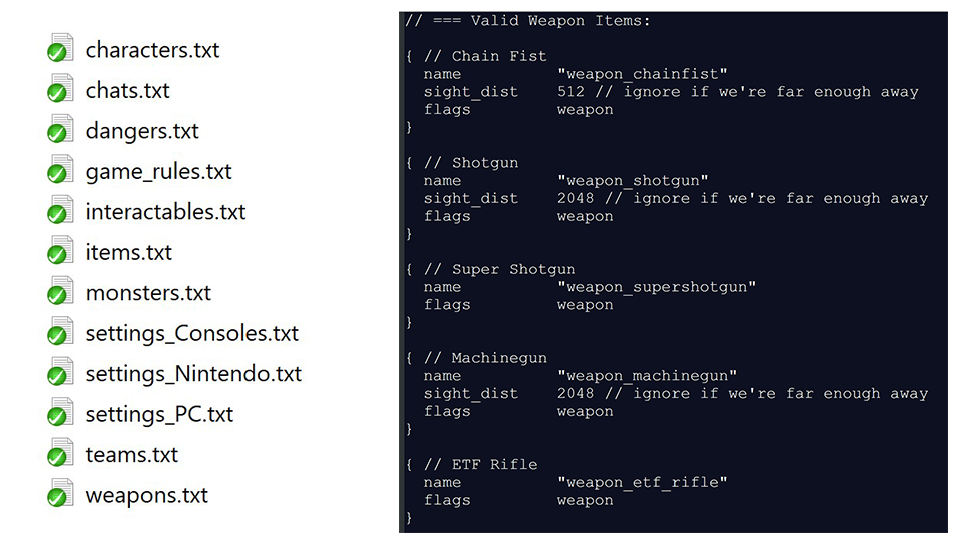
Improved Navigation Editor
The enhanced release of Quake II allows you to set up navigation on any map quickly with helpful info and feedback provided in the editor. The NAV file created by the editor is saved as a separate file that can be shared in your mod or with friends.
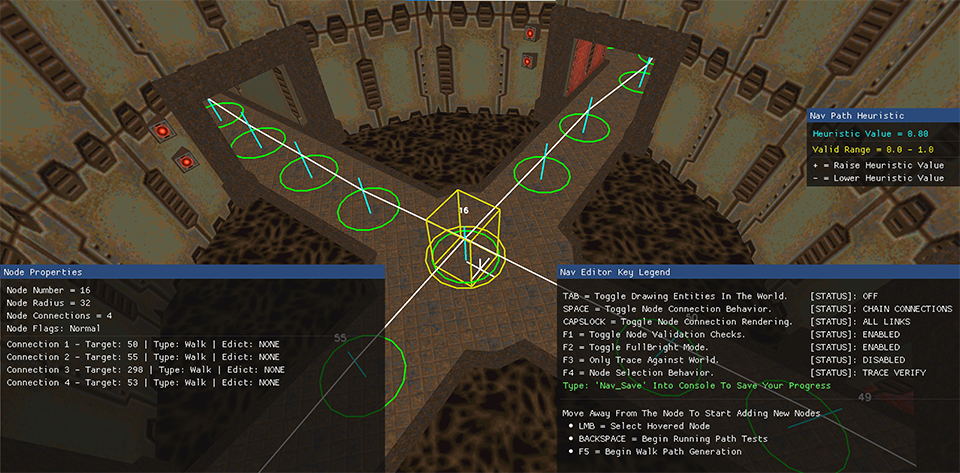
Improved Debugging Tools
Various bot debugging tools are available, allowing you to debug a specific bot and issue it commands or see their thinking.
These debugging tools allow you to:
- Show info about the bot's general state, goals, etc
- Show the current state of the bot's behavior system
- Show info about the game mode and the items/entities the bot cares about
- Give the bots move goals in the world for navigation testing
- Show what enemies they can see and who they are attacking
- Show the current state of the bot's weapon system and their available inventory

Debug Lines
You can now draw simple primitives from the game code. These allow you to draw things like the location of an entity, world text or even the direction something is moving, all of which can be useful for debugging.
Available debug render primitives:
- Line
- Point
- Circle
- Bounds
- Sphere
- Oriented World Text (this always orients itself toward the local client's view)
- Static World Text
- Cylinder
- Ray
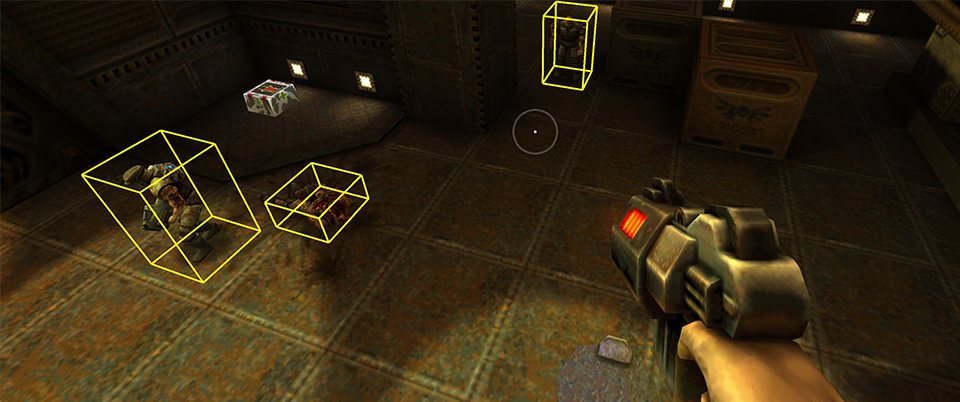
Good shit. Better than Doom Eternal.
retardgrand
Novice
- Joined
- Nov 10, 2022
- Messages
- 6
The problem with Quake 2 is that the enemies are incredibly non threatening and the game is painfully easy. This is actually a similar problem Doom 1 has, where every projectile enemy (imp, caco, baron) functions basically the same. I don't remember all the enemies in Quake 2 but most of them were just "I will now fire a single rocket/projectile precisely at your current position" and you can mostly just circle strafe around all of them. Or just quickly peek from cover. The biggest joke are those melee robots which are even more useless than pinkies.
Funny thing is that Doom 2 already tried to rectify this - Revenants with homing missiles, Arachnotrons with a large rate of fire, Mancubi which fire multiple shots but in a predictable pattern. Once Romero and Petersen left, this was somehow totally lost.
Funny thing is that Doom 2 already tried to rectify this - Revenants with homing missiles, Arachnotrons with a large rate of fire, Mancubi which fire multiple shots but in a predictable pattern. Once Romero and Petersen left, this was somehow totally lost.

The regular guard enemies can now go prone to dodge and attack too.
DemonKing
Arcane
- Joined
- Dec 5, 2003
- Messages
- 6,581
Apparently they've "fixed" this in the remaster in that they now have an incredibly long reach that can hit you around corners.The biggest joke are those melee robots which are even more useless than pinkies.
Will download on Gamepass tonight and check it out - have fond memories of the original but never played the expansion packs. I loved the Quake 1 remake they did a couple of years back (although I never played the original).
randir14
Augur
- Joined
- Mar 15, 2012
- Messages
- 762
The AI was revamped in the remaster. I've seen some new behaviors that make it harder, like enemies pre-firing rocket volleys at a corner if they knew I was on the other side. And all enemies in general seem to shoot faster and are more aggressive in chasing after the player. The melee guys have a new leap attack that's dangerous if you're fighting them near lava since they can knock you in.The problem with Quake 2 is that the enemies are incredibly non threatening and the game is painfully easy. This is actually a similar problem Doom 1 has, where every projectile enemy (imp, caco, baron) functions basically the same. I don't remember all the enemies in Quake 2 but most of them were just "I will now fire a single rocket/projectile precisely at your current position" and you can mostly just circle strafe around all of them. Or just quickly peek from cover. The biggest joke are those melee robots which are even more useless than pinkies.
Funny thing is that Doom 2 already tried to rectify this - Revenants with homing missiles, Arachnotrons with a large rate of fire, Mancubi which fire multiple shots but in a predictable pattern. Once Romero and Petersen left, this was somehow totally lost.
- Joined
- Mar 25, 2012
- Messages
- 2,334





I just tried for a bit the GOG version (if you have the original on GOG or Steam you'll get this for free). It is basically Quake 2 on a modified engine, though with some minor alterations to the gameplay. My favorite feature so far (i've only played a few maps) is that they fixed the hitbox for the fishes.
I didn't try the new maps (or the Quake II 64 maps) but i liked the "id Vault" which has a bunch of concept art, design docs, etc and even includes a couple of playable prerelease maps (ported to the new engine), an early version video and a 3D model viewer for some early and abandoned models.
They recreated the cinematics which is nice but TBH i found them as boring as the originals. The sound is a bit easier to listen though, now i actually understand WTF they're saying.
I didn't try the new maps (or the Quake II 64 maps) but i liked the "id Vault" which has a bunch of concept art, design docs, etc and even includes a couple of playable prerelease maps (ported to the new engine), an early version video and a 3D model viewer for some early and abandoned models.
They recreated the cinematics which is nice but TBH i found them as boring as the originals. The sound is a bit easier to listen though, now i actually understand WTF they're saying.
Morenatsu.
Liturgist
If by 'original' you mean OpenGL on modern video cards with default brightness, that was always much darker than it was supposed to be. The miniGL driver is supposed to have a super washed-out gamma of 1.7 or something.Lighting is a lot brighter than the original.
















